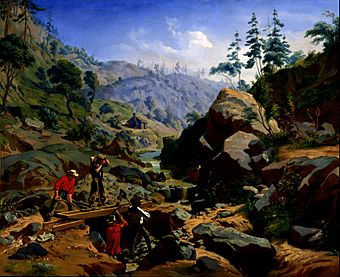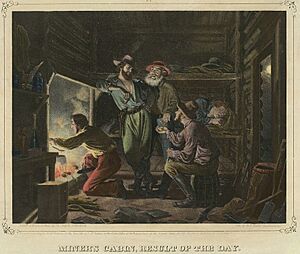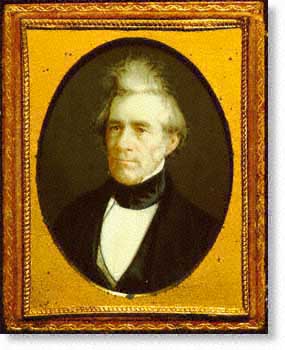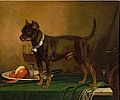Frederick August Wenderoth facts for kids
Quick facts for kids
Frederick August Wenderoth
|
|
|---|---|

Miners in the Sierra
|
|
| Born | 1819 Cassel, Germany
|
| Died | 1884 (aged 64–65) Philadelphia, US
|
| Education |
|
Frederick August Wenderoth (1819 – 1884) was a talented artist. He was born in Germany but later moved to America. He was known for both his paintings and his photographs.
Wenderoth learned to paint from his father in Cassel, Germany. There, he became best friends with another artist, Charles Christian Nahl. Because of some political problems in Germany, Wenderoth moved to Paris. His friend Nahl and Nahl's half-brother, Arthur, soon joined him there.
In 1848, they all moved to the United States. They first lived in New York. Then, they traveled by ship to California to join the California Gold Rush. They hoped to find gold, but they weren't very successful as miners. So, Wenderoth and Nahl opened art studios instead. They worked together in Sacramento and later in San Francisco. They created paintings, engravings, and photographs.
After a trip to the South Seas and Australia, Wenderoth got married. He then moved to Philadelphia, Pennsylvania, on the East Coast. There, he started his own photography studio. In the late 1850s, he worked in South Carolina for a while. He even invented new ways to take and process photos, like the ivory-type and photozincography. Wenderoth passed away in 1884 from a serious illness.
Contents
Frederick Wenderoth's Early Life
Frederick August Wenderoth was born in 1819 in Cassel, Germany. His father was a painter, and his mother worked for the royal family. When Frederick was a child, his father taught him how to paint. He later studied at the art academy in Cassel. There, he met Carl Christian Nahl, who became his lifelong friend. By the age of 18, Wenderoth was already giving art lessons to young women at the royal court.
In 1845, during a time of political trouble, he left Germany for Paris. From Paris, he traveled to Algeria. When he returned to Paris, Nahl and his family joined him. The two friends visited famous art museums like the Louvre. Wenderoth also studied art with a teacher named Léon Cogniet.
In 1849, Wenderoth and the Nahl family moved to the United States. They settled in Brooklyn, New York. Between 1849 and 1850, he showed and sold his paintings at art shows.
Joining the California Gold Rush
In 1851, Wenderoth and the Nahl family decided to join the California Gold Rush. Traveling by sea to the goldfields was much easier than the long, dangerous journey by land. People who traveled by sea from the eastern United States were called "Argonauts." Wenderoth and the Nahls left New York in March. They traveled by ship to Havana, Cuba, then to Chagres, Panama. They walked across the narrow Isthmus of Panama. From there, they took another ship to San Francisco, arriving in May.

Most Argonauts stayed in San Francisco to rest and get supplies. But Wenderoth and the Nahls left the very next day. They headed inland to the goldfields near the Yuba River in the Sierras. They arrived in Rough and Ready. The two friends, with Nahl's half-brother Arthur, tried to find gold along Deer Creek. But they found out the area had been tricked to look like it had gold.
Instead of mining, they started sketching the miners. Wenderoth might have even taken early photographs called daguerreotypes of the miners. Their experiences in the mining camps were captured in two lithographs. These were printed pictures signed by both artists. One showed the inside of a miner's cabin at night. The other showed a miner looking for gold. These pictures were important because they inspired later famous paintings.
By the end of 1851, the friends moved to Sacramento. They opened an art studio there. They sold paintings that showed scenes from the gold rush. A local newspaper wrote about them in 1852. It said people in Sacramento could now enjoy their beautiful art. The newspaper also mentioned they took photos, but this is not fully confirmed. They likely painted tiny portraits, possibly based on early photographs.
They probably painted their large work, Miners in the Sierra, around this time. This painting shows four miners working together in a mountain canyon. They are using a sluice box to get gold from the river. One expert said the painting is "powerful and real." It shows how much hard work it took to find riches in the earth. Wenderoth and Nahl also made engravings for local newspapers.
A Photographer and Miniaturist
A big fire in Sacramento destroyed their artwork. So, they moved to San Francisco. There, they opened a new studio and quickly became well-known. In 1853, an author asked Wenderoth and Nahl to create illustrations for his book. A year later, they were advertising themselves as daguerreotype photographers. Wenderoth also painted tiny portraits during this time. These were often based on daguerreotype images. They were painted on very thin ivory with watercolors, like his 1854 Portrait of a Man.

Between 1852 and 1853, Wenderoth traveled to the South Seas and Australia. When he returned in 1856, he married Laura, Nahl's half-sister. The couple moved to Philadelphia, Pennsylvania, planning to settle down. Sadly, Laura passed away shortly after, along with their baby.
In 1857, Wenderoth lived in Charleston, South Carolina. He started a business with Jesse H. Bolles for about a year. During this time, he seemed to improve color ambrotypes and ivory types. Ivory types were made by putting a photograph and a painting of the same person together. They were then sealed with beeswax.
In 1858, he returned to Philadelphia. Wenderoth worked for Harper's Weekly, making pictures and photographs. He opened a studio with his partner, William Curtis Taylor. A famous miniaturist, John Henry Brown, also joined them. Their company focused on adding color to photographs. At the time, photos were popular but were not as colorful as paintings. Wenderoth and his team created special ways to add color. These were called "Ivorytypes," "Opalotypes," and the "New Crayon." These techniques made photos look more like paintings, which made them more popular.
Wenderoth passed away in Philadelphia in 1884.
Images for kids




